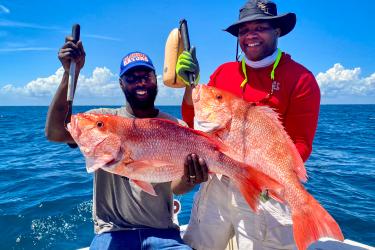An intergovernmental task force just released a new plan to prevent the spread of the invasive lionfish and to help manage lionfish in an effort to prevent further harm to marine ecosystems.
The Aquatic Nuisance Species Task Force (ANSTF) is pleased to announce the availability of the National Invasive Lionfish Prevention and Management Plan.
Two lionfish species (Pterois volitans and P. miles) represent the first non-native marine finfish to become established in U.S. marine waters. Introduced into the southeast Atlantic through the U.S. aquarium trade in the 1980s, lionfish are firmly established from North Carolina to South America, including the Gulf of Mexico. Lionfish are opportunistic predators that consume a wide variety of prey. Lionfish have been documented to reduce native fish populations by up to 80 percent, ultimately disrupting the delicate ecological balance of coral reef ecosystems. While lionfish represent a significant ecological threat, the invasion also has social and economic consequences. For example, lionfish prey on economically important species such as juvenile grouper and snapper. These species are an important component of a multi-billion dollar per year fishery that supports thousands of jobs in the invaded range. Lionfish are also a safety risk to commercial and recreational divers, snorkelers, swimmers, and anglers because of their venomous spines.
Most scientists agree that the large geographic range and depths to more than 1000 feet that lionfish now occupy make it unlikely that the invasion can be reversed. Scientists do believe, however, that lionfish can be controlled in some locations, such as marine protected areas. It is critical to learn as much as possible from this invasion to determine how the species is spreading, the potential impacts, and possible ways to control and manage a marine invasive finfish.
To further this understanding, the National Invasive Lionfish Prevention and Management Plan was developed as a guide to the ANSTF and other interested parties involved in managing lionfish and natural resources in U.S. waters. The main goals of the Plan are to prevent the spread of invasive lionfish; coordinate early detection and rapid response efforts; control and manage existing lionfish populations; and fully assess the impact that the invasion is having on native species and habitats. Click here to access the Plan.
In addition to the National Lionfish Plan, NOAA has recently released its National Marine Sanctuaries Lionfish Response Plan (2015-2018). The response plan includes actions to minimize the impact of this unprecedented marine invasion within the National Marine Sanctuaries. Four national marine sanctuaries have been invaded by lionfish – Gray’s Reef, Florida Keys, Flower Garden Banks, and Monitor. Accordingly, NOAA’s Lionfish Response Plan complements the ANSTF’s National Lionfish Plan, as well as other plans such as the Regional Strategy for the Control of Invasive Lionfish in the Wider Caribbean and the National Park Service Lionfish Response Plan. To access NOAA’s National Marine Sanctuaries Lionfish Response Plan (2015-2018), please visit: http://sanctuaries.noaa.gov/science/conservation/pdfs/lionfish15.pdf
NOAA has also partnered with the Gulf and Caribbean Fisheries Institute (GCFI) to launch a new web portal to provide managers, researchers, and the public with the latest information on the lionfish invasion in the Atlantic. The Invasive Lionfish Web Portal (http://lionfish.gcfi.org/index.php) provides information for coastal managers, educators and the public on the lionfish invasion and its impacts by providing training videos, fact sheets, examples of management plans, and guidelines for monitoring.
The ANSTF is an intergovernmental organization dedicated to preventing and controlling aquatic nuisance species (ANS) and coordinating governmental efforts dealing with ANS in the U. S. with those of the private sector and other North American interests. ANSTF responsibilities include the development of management plans for specific high-risk invasive species to minimize the impact to areas where the species have already invaded and prevent spread into additional habitats. The plans are developed through a cooperative process and undergo review by the ANSTF members and Regional Panels, yet implementation of the plans requires participation from numerous entities at the federal, state, tribal, regional, and local levels.


